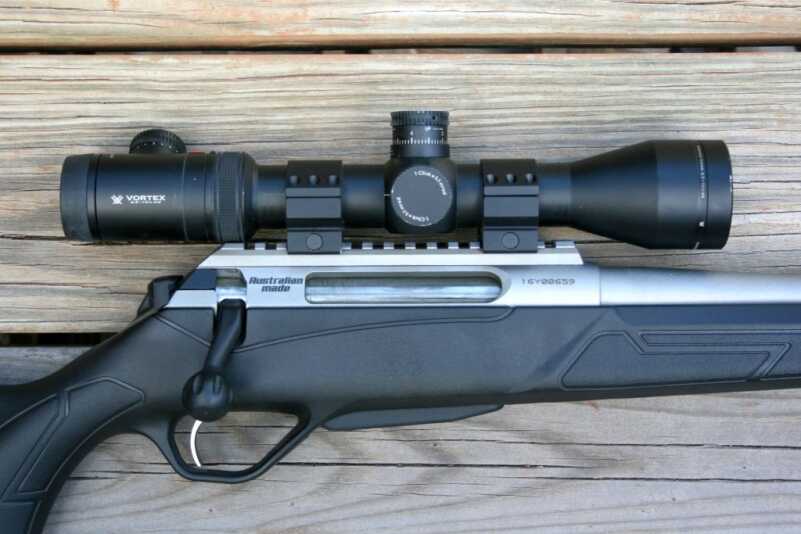
Check out all of articles in the Fall edition of Long Range Shooting, GunsAmerica’s newest specialty publication.
How do you tell if a riflescope is first or second focal plane? When you look through a first focal plane riflescope, the reticle increases in size as you dial magnification up, and shrinks in size as you dial magnification down.
With a second focal plane riflescope, the reticle stays the same size regardless of the magnification setting. There are different styles of shooting, and not all shooters use their reticles in the same way.

Some hunters zero their rifle at 175 and only take game out to 300 yards. Some hunters prefer a ballistic drop style reticle configured for their specific caliber and take shots out to 500 yards. Some long-range marksman “dial” elevation into all their shots, while others use a Horus-style reticle and hold for wind and elevation.

This Vortex PST 2.5-10X is a second focal plane rifle scope that is perfect for hunting.
During the last decade, I have observed a push towards first focal plane riflescopes. First focal plane riflescopes are more expensive and are, in my opinion, optimized for marksman who need a riflescope with a magnification of 14 power or higher. Unlike second focal plane scopes, the subtensions in a first focal plane riflescope represent the same angular measurement regardless of magnification setting. Subtensions in a second focal plane scope are calibrated for a specific magnification setting, usually the highest power of magnification.

Bushnell HDMR and FFP Nikko Stirling 4-14. Both of these scopes are first focal plane.
So, in what scenarios are second focal plane scopes optimal? 1-4, 1-6, or 1-8 powered riflescopes are awesome when configured in the second focal plane. On many 1-6 and 1-8 powered first focal plane riflescopes I test, the reticle becomes a jumbled mess when dialed down to 1 power. Unless the riflescope had a bright illuminated reticle, the riflescope was pretty much worthless on 1 power. In contrast, second focal plane reticles do not shrink. As a result, when dialed down to 1 power the scope still has a nice clean reticle.
Second focal plane scopes also shine for riflescopes in the 2–10, 3- 9, 4-12, and 4-14 magnification range. If as a hunter you have your scope magnified at 8-power, and you see an animal within 200 yards, you simply point and shoot. If the animal is further away, you dial up to max power and use your reticle for the shot. I have frequently hunted with both first and second focal plane riflescopes. In heavy timber or a rainstorm, dialing a first focal plane riflescope to a low setting rendered my reticle useless. I have been in the same scenarios with a second focal plane riflescope, also dialed down to a low power, and had the benefit of a nice clean reticle.
First focal plane scopes are currently all the rage, but I think second focal plane scopes offer a lot of advantages. Both platforms shine in different circumstances, and I shoot with both. For hunting, I use a second focal plane, but for long range work I prefer a first focal plane. There is a place for second focal plane scopes in long range shooting as highlighted by the video below
A quick tip when using a second focal plane scope: set up a target at 100 yards and true your reticle. For example, if you have a second focal plane Vortex Viper PST 2.5 – 10X riflescope, and the reticle subtensions represent 1 mil at 100 yards, set up a piece of paper at 100 yards and, with a ruler, draw large dots every 3.6 inches. Adjust your magnification until your reticle matches the dots and note the trued magnification with a paint marker, or soap pen. Some riflescope subtensions are accurate, while others may be off by a small amount. If it is off by a large amount, call your manufacturer and send it back. This can be a complex subject, so feel free to leave questions in the comments below and I will answer them.
To purchase a riflescope on EuroOptic, click here.

<>
This is probably a dumb question, but am I correct in assuming that’s center to center of the dots, and not outside edge to outside edge?
“with a ruler, draw large dots every 3.6 inches” – this didn’t appear inside the arrows after submitting.
Ik when doing range estimation w/a Mil-Dot reticle, your scope should always be on full power when Milling out ur target. Is this the case with both FFP & SFP scopes? Or just SFP since the reticle remains same size no matter power setting?
Thanks..Semper Fidelis
Good article! Should be most helpful to those looking for either hunting scope or long range! Thanks!
I believe in Second focus Plan the recital is small and will not cover your target in long range I call it pin pointing put a pin point on the target like you see a shirt out there with buttons take one of the button out. I’m an instructor in rifle and teach long range shooting its AL about what you like and comfortable with I can only tell you what I used and still use S.F.P.
I shoot a lot last year through one rifle 17HMR custom I shot 4400 round that’s just one rifle.
One last comment buy a GOOD scope it will cost so bucks its worth it .
BIG PHIL SEMPER-FI
Why do you like Mils over MOA?
For long range work I prefer MIL, but when it comes to hunting I still think in minutes. They both work. Mils have the advantage for Military application. Minutes for F Class. Give me either or and I will make it work.